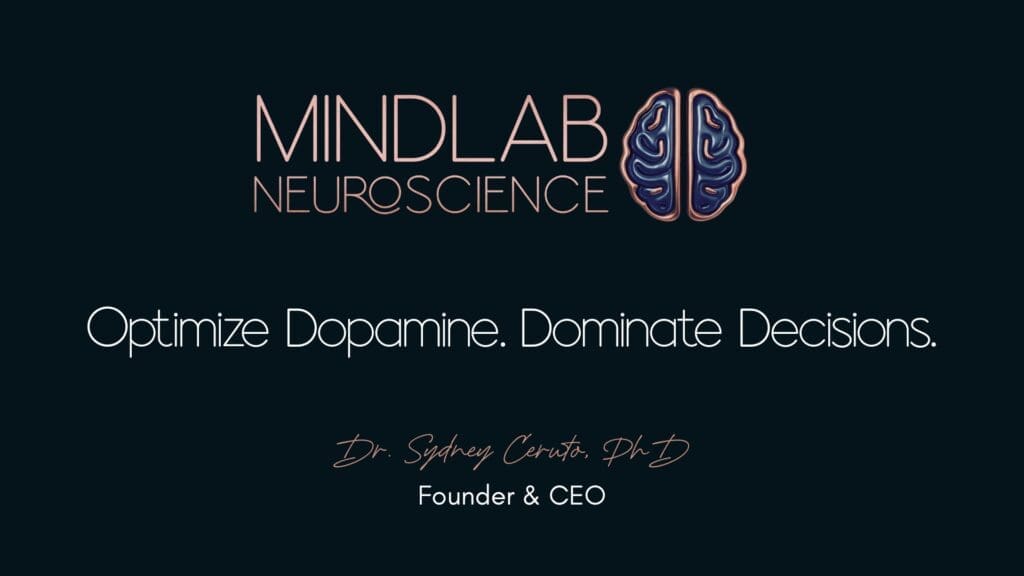The corner office shouldn’t feel like a cage. Yet for too many high-performing executives, exceptional achievement comes with a hidden cost—chronic exhaustion, decision paralysis, and the nagging sense that despite working harder than ever, cognitive performance keeps declining. What separates leaders who maintain razor-sharp focus under crushing pressure from those who burn out spectacularly? The answer lies in dopamine workplace performance, the neuroscience framework transforming how elite executives optimize their brains for sustained excellence.
Recent research reveals that 78 percent of executives report chronic mental exhaustion, while 65 percent experience anxiety before high-stakes decisions. This isn’t a willpower problem—it’s a dopamine problem. Understanding dopamine workplace performance means recognizing that your brain’s motivation and reward systems determine whether you thrive in high-pressure environments or succumb to decision fatigue, cognitive overload, and eventual burnout. The executives commanding premium salaries and transforming organizations aren’t genetically superior—they’ve mastered the neuroscience of dopamine workplace performance.
The Neuroscience Foundation of Dopamine Workplace Performance
Dopamine workplace performance centers on understanding how this critical neurotransmitter governs motivation, focus, reward anticipation, and cognitive stamina. Dopamine originates in the ventral tegmental area and substantia nigra, projecting throughout the prefrontal cortex, striatum, and limbic system—the exact brain regions controlling executive function, decision-making, and emotional regulation.
Here’s what most productivity advice misses: dopamine isn’t about feeling good—it’s about wanting, about the anticipation and pursuit of goals rather than their achievement. This distinction revolutionizes dopamine workplace performance strategies. When executives understand that dopamine surges during goal pursuit, not completion, they can structure work environments and reward systems that maintain motivation across extended timelines rather than creating boom-bust cycles of intensity and collapse.
The prefrontal cortex, your brain’s executive control center, requires optimal dopamine levels to function effectively. Too little dopamine creates apathy, procrastination, and difficulty initiating tasks—the hallmarks of dopamine depletion many high-achievers experience after prolonged stress. Too much dopamine triggers impulsivity, distractibility, and poor strategic thinking. Elite dopamine workplace performance means operating within your optimal dopamine zone where motivation, focus, and cognitive flexibility align perfectly.
Research from Vanderbilt University demonstrates that dopamine concentration in the striatum and prefrontal cortex directly predicts willingness to work for rewards, even when effort requirements are high. This explains why some executives maintain relentless drive while others with identical workloads experience motivation collapse. Dopamine workplace performance isn’t about character—it’s about neurochemistry, and neurochemistry can be optimized.
The dopamine reward pathway creates a powerful feedback loop: anticipating success triggers dopamine release, which enhances focus and effort, leading to achievement, which reinforces the pathway. Executives who master dopamine workplace performance engineer their environments to trigger this cycle consistently through clear milestone setting, immediate feedback mechanisms, and strategic recognition systems.

Decision Fatigue and the Dopamine Depletion Crisis
High-stakes decision making depletes dopamine and glucose in the prefrontal cortex with frightening efficiency. Adults make approximately 35,000 decisions daily, but executives face significantly higher numbers—CEOs average 50 high-stakes decisions per day. Each decision consumes finite neurochemical resources, and once depleted, dopamine workplace performance craters dramatically.
Decision fatigue manifests as impaired judgment, increased impulsivity, or complete decision avoidance—the worst possible outcomes for leaders responsible for organizational direction. Cambridge University research found that 60 percent of executives experience significantly impaired judgment after prolonged decision-making sessions. This isn’t weakness—it’s predictable neurobiological outcome when dopamine and glucose reserves run dry.
The prefrontal cortex, operating on limited metabolic resources, shows measurable efficiency decreases of 11 to 13 percent with sleep deprivation alone—equivalent to losing a full IQ standard deviation for complex reasoning. Add chronic stress flooding the system with cortisol, and the prefrontal cortex shifts from strategic thinking to survival mode, with the amygdala hijacking decision processes. Understanding dopamine workplace performance means recognizing these biological limits and implementing countermeasures before cognitive collapse occurs.
Strategic leaders implementing dopamine workplace performance principles reduce daily decision volume through automation, delegation, and pre-commitment strategies. Steve Jobs’ famous black turtleneck wasn’t eccentricity—it was neuroscience-informed decision conservation. Every trivial choice eliminated preserves dopamine for high-stakes decisions where exceptional judgment creates competitive advantage.
Cognitive load management represents a critical dimension of dopamine workplace performance. When working memory capacity exceeds optimal levels, even high-performing individuals experience choking under pressure. Research demonstrates that increased salivary cortisol during math tasks correlates with hippocampal deactivation—the brain literally cannot simultaneously manage stress responses and perform complex cognitive work. Executives optimizing dopamine workplace performance structure their schedules to minimize simultaneous demands, creating cognitive space for strategic thinking rather than reactive firefighting.
Flow States: The Ultimate Dopamine Workplace Performance
Flow states represent the pinnacle of dopamine workplace performance—that elusive zone where hours feel like minutes, distractions disappear, and performance increases 200 to 500 percent above baseline. Hungarian psychologist Mihaly Csikszentmihalyi pioneered flow research, discovering that people report greatest happiness and productivity when completely immersed in challenging tasks matching their skill level.
The neuroscience of flow reveals why this state supercharges dopamine workplace performance. During flow, the prefrontal cortex undergoes transient hypofrontality—temporary deactivation of the inner critic and self-referential thinking that normally consumes cognitive resources. Simultaneously, the brain releases a neurochemical cocktail including dopamine, norepinephrine, endorphins, anandamide, and serotonin—creating intense focus, heightened pattern recognition, and amplified learning capacity.
Flow requires precise conditions: clear goals, immediate feedback, and challenge-skill balance at the optimal “four percent rule”—tasks just difficult enough to stretch abilities without overwhelming them. Executives mastering dopamine workplace performance intentionally structure work to trigger flow rather than waiting for accidental occurrence. This means eliminating distractions, batching similar tasks, and protecting uninterrupted time blocks for deep strategic work.
The locus coeruleus-norepinephrine system plays a central role in flow-based dopamine workplace performance. In exploitation mode (focused task execution), moderate norepinephrine facilitates sustained attention and effort expenditure, while the default mode network—responsible for mind-wandering and self-referential thinking—shows decreased activity. This neurobiological shift explains why flow feels effortless despite requiring intense cognitive engagement.
Pupillometry studies demonstrate that individuals in flow states show optimal arousal levels—neither under-aroused (boredom) nor over-aroused (anxiety)—with mean pupil dilation indicating balanced tonic norepinephrine levels. This inverted U-shaped relationship between arousal and performance underscores why dopamine workplace performance requires precise calibration rather than simply “getting pumped up” for important tasks.
Elite athletes, musicians, and knowledge workers describe flow using remarkably consistent language: “in the zone,” “playing unconscious,” “in rhythm”. These aren’t metaphors—they’re descriptions of a distinct neurophysiological state where action and awareness merge, time distorts, and performance reaches peak levels. For executives, accessing flow regularly transforms dopamine workplace performance from sporadic brilliance to reliable excellence.

Dopamine-Aware Leadership and Team Performance
Individual dopamine workplace performance creates impressive results, but dopamine-aware leadership multiplies impact across entire organizations. Research shows that when leaders understand and intentionally trigger dopamine pathways in their teams, measurable increases occur in motivation, engagement, productivity, and resilience.
Dopamine-aware leadership recognizes that team motivation depends on the collective anticipation of progress and success rather than waiting for final outcomes. Breaking large objectives into smaller milestones creates frequent dopamine releases that sustain momentum across extended projects. A tech startup struggling with product delays implemented this approach, restructuring goals to celebrate incremental achievements, which reignited team motivation and enabled them to meet revised deadlines while rebuilding organizational culture.
Recognition systems powerfully influence dopamine workplace performance. Neuroscience demonstrates that effort-focused feedback—specific praise for persistence, innovation, or collaboration—reliably maintains engagement because it triggers dopamine release while reinforcing desired behaviors. Leaders implementing regular, detailed recognition that acknowledges genuine contributions see sustained team performance rather than motivational burnout from overreliance on monetary incentives alone.
Gamification elements introduce play, competition, and reward structures that serve as excellent dopamine triggers for workplace performance. Leaderboards, progress tracking, friendly competitions with tangible rewards, and achievement celebrations create engagement without the overhead of constant managerial intervention. When properly designed, these systems create positive feedback loops where dopamine-driven satisfaction from small wins motivates continued high performance.
IBM’s neuroscience leadership training increased employee satisfaction and performance by teaching managers to deliver feedback consistently and empathetically, while Coca-Cola implemented recognition rituals fostering collaboration and creativity. These Fortune 500 applications demonstrate that dopamine workplace performance principles scale from individual executives to enterprise-level organizational transformation.
Social connections also modulate dopamine workplace performance. Positive interactions stimulate dopamine release, improve team cohesion, and reduce stress. Leaders who foster genuine relationships through team-building activities, regular check-ins, and creating psychological safety see teams that maintain higher baseline motivation and recover from setbacks more quickly. This isn’t soft skills—it’s strategic neurochemistry optimization for sustained organizational performance.

Executive Burnout: When Dopamine Workplace Performance Collapses
Executive burnout represents the catastrophic failure of dopamine workplace performance systems. Unlike simple fatigue, burnout constitutes biological bankruptcy—the complete depletion of dopaminergic and other neurochemical resources necessary for motivation, decision-making, and emotional regulation. Harvard Business Review reports that 78 percent of executives experience chronic exhaustion, with many hiding panic attacks and mental health crises behind polished professional facades.
The neuroscience of burnout reveals structural brain changes. Chronic cortisol floods the prefrontal cortex, shrinking gray matter and reducing decision-making capacity by 26 percent. Neural pathways default to threat detection, transforming routine interactions into perceived attacks and converting previously energizing challenges into overwhelming burdens. This isn’t psychological weakness—it’s measurable neurological damage requiring targeted intervention beyond standard “take a vacation” advice.
Dopamine depletion in burnout creates an “anti-reward state” where activities that once provided satisfaction now generate apathy or aversion. Legal professionals experiencing chronic high-stakes pressure describe needing constant crisis just to feel “switched on,” creating unconscious stress addiction that further depletes dopaminergic reserves. The brain builds tolerance to dopamine stimulation, requiring ever-increasing intensity to achieve the same motivational response—a neurochemical treadmill leading inexorably toward collapse.
Modern work culture accelerates dopamine depletion through constant digital stimulation, chronic stress, inadequate sleep, and processed diets lacking dopamine precursors. Endless notifications hijack reward pathways with trivial dopamine hits, sabotaging the brain’s capacity for sustained focus on meaningful goals. Over time, professionals lose access to authentic reward experiences—goal achievement, creative breakthroughs, collaborative success—that once fueled career satisfaction.
Recovery requires neural rehabilitation, not mere rest. Evidence-based protocols combine morning light therapy to reset cortisol rhythms, cognitive reframing exercises, strategic dopamine-boosting activity blocks, and structured breaks that replenish neurotransmitter reserves. One CFO regained strategic clarity within six weeks using neuroscience-based recovery protocols, with immediate positive impact noticed by his leadership team. Restoring dopamine workplace performance after burnout demands systematic intervention addressing neurobiological reality rather than superficial lifestyle adjustments.
Practical Strategies for Optimizing Dopamine Workplace Performance
Translating neuroscience into actionable dopamine workplace performance requires systematic implementation across multiple domains.
Goal Architecture: Structure objectives using the neuroscience-validated approach of clear, achievable milestones that trigger regular dopamine releases. Break complex projects into “micro-wins” that provide frequent positive reinforcement rather than single distant targets. Each small victory releases dopamine, maintaining motivation across extended timelines. This approach counters the dopamine depletion that occurs when rewards feel impossibly distant.
Decision Conservation: Implement pre-commitment strategies, automation, and strategic delegation to reduce daily decision volume below the critical threshold where cognitive performance collapses. Create morning routines eliminating trivial choices, establish clear decision-making frameworks for recurring situations, and reserve cognitive resources for high-stakes judgment calls where expertise creates disproportionate value. Executives mastering this principle report dramatic improvements in strategic clarity and reduced mental exhaustion.
Cognitive Load Management: Protect prefrontal cortex capacity through structured breaks that replenish glucose and dopamine. Research shows that strategic pauses prevent cognitive overload and sustain productivity for longer periods. Implement the Pomodoro Technique or similar time-boxing methods that align with the brain’s natural attention cycles. Schedule cognitively demanding work during peak mental energy periods—typically morning hours for most executives—and reserve routine tasks for afternoon energy dips.
Flow Triggers: Engineer work environments to facilitate flow states by eliminating distractions, matching challenge to skill level, establishing clear immediate goals, and creating uninterrupted time blocks. Even 90-minute daily flow sessions dramatically enhance dopamine workplace performance compared to fragmented attention scattered across endless interruptions. Track flow frequency and duration, iteratively refining conditions that consistently trigger optimal states.
Stress Modulation: Implement evidence-based stress management protecting cognitive function during high-pressure periods. Mindfulness practices strengthen prefrontal cortex regulation of the amygdala, preventing emotional hijacking during critical decisions. Deep breathing exercises before important meetings reset autonomic nervous system activation, restoring access to strategic thinking when stress threatens to trigger reactive survival responses.
Recognition Systems: Build personal and team recognition rituals that provide regular dopamine boosts through acknowledgment of effort, progress, and achievement. Immediate feedback creates stronger neurochemical reinforcement than delayed recognition, so implement real-time acknowledgment systems rather than waiting for quarterly reviews. Celebrate process improvements and learning as enthusiastically as final outcomes to maintain motivation during challenging projects.
Lifestyle Optimization: Support dopamine synthesis through adequate sleep (7-9 hours), regular exercise, protein-rich diets providing tyrosine and phenylalanine precursors, sunlight exposure, and strategic supplementation when appropriate. These foundational elements seem basic, but they determine baseline dopaminergic capacity—the neurochemical substrate upon which all other dopamine workplace performance strategies depend.

Your Competitive Neurochemical Advantage
Dopamine workplace performance represents the decisive factor separating executives who sustain excellence from those who crash spectacularly despite equivalent intelligence, education, and work ethic. Understanding the neuroscience of motivation, decision-making, flow states, and burnout prevention isn’t academic luxury—it’s competitive necessity in environments where cognitive performance directly determines organizational outcomes and career trajectories.
The research is unambiguous: leaders who optimize dopamine workplace performance through neuroscience-based strategies demonstrate measurably superior decision quality, sustained motivation, enhanced creativity, and resilience under pressure compared to peers relying on willpower and caffeine alone. This advantage compounds over time—small daily improvements in cognitive efficiency create exponential returns across decades-long careers.
Elite performance isn’t about working harder or longer hours. It’s about working smarter by aligning daily routines, environmental design, goal structures, and recovery protocols with brain biology rather than fighting against it. Dopamine workplace performance provides the framework for this alignment, translating abstract neuroscience into concrete practices that optimize the most valuable asset in any organization—executive cognitive capacity.
The executives commanding premium compensation and transforming industries have discovered what neuroscience confirms: your brain’s dopamine systems can be understood, optimized, and leveraged for sustained peak performance. The question isn’t whether dopamine workplace performance matters—it’s whether you’ll master these principles before or after your competition.
Your brain has been operating on dopamine systems since birth. Now you can finally optimize them intentionally rather than hoping motivation magically appears when pressure mounts. That’s the promise and power of dopamine workplace performance—transforming neurochemistry into your unfair advantage.
The future belongs to leaders who understand their brains. Are you ready to optimize yours?
The corner office shouldn’t feel like a cage. Yet for too many high-performing executives, exceptional achievement comes with a hidden cost—chronic exhaustion, decision paralysis, and the nagging sense that despite working harder than ever, cognitive performance keeps declining. What separates leaders who maintain razor-sharp focus under crushing pressure from those who burn out spectacularly? The answer lies in dopamine workplace performance, the neuroscience framework transforming how elite executives optimize their brains for sustained excellence.
Recent research reveals that 78 percent of executives report chronic mental exhaustion, while 65 percent experience anxiety before high-stakes decisions. This isn’t a willpower problem—it’s a dopamine problem. Understanding dopamine workplace performance means recognizing that your brain’s motivation and reward systems determine whether you thrive in high-pressure environments or succumb to decision fatigue, cognitive overload, and eventual burnout. The executives commanding premium salaries and transforming organizations aren’t genetically superior—they’ve mastered the neuroscience of dopamine workplace performance.

The Neuroscience Foundation of Dopamine Workplace Performance
Dopamine workplace performance centers on understanding how this critical neurotransmitter governs motivation, focus, reward anticipation, and cognitive stamina. Dopamine originates in the ventral tegmental area and substantia nigra, projecting throughout the prefrontal cortex, striatum, and limbic system—the exact brain regions controlling executive function, decision-making, and emotional regulation.
Here’s what most productivity advice misses: dopamine isn’t about feeling good—it’s about wanting, about the anticipation and pursuit of goals rather than their achievement. This distinction revolutionizes dopamine workplace performance strategies. When executives understand that dopamine surges during goal pursuit, not completion, they can structure work environments and reward systems that maintain motivation across extended timelines rather than creating boom-bust cycles of intensity and collapse.
The prefrontal cortex, your brain’s executive control center, requires optimal dopamine levels to function effectively. Too little dopamine creates apathy, procrastination, and difficulty initiating tasks—the hallmarks of dopamine depletion many high-achievers experience after prolonged stress. Too much dopamine triggers impulsivity, distractibility, and poor strategic thinking. Elite dopamine workplace performance means operating within your optimal dopamine zone where motivation, focus, and cognitive flexibility align perfectly.
Research from Vanderbilt University demonstrates that dopamine concentration in the striatum and prefrontal cortex directly predicts willingness to work for rewards, even when effort requirements are high. This explains why some executives maintain relentless drive while others with identical workloads experience motivation collapse. Dopamine workplace performance isn’t about character—it’s about neurochemistry, and neurochemistry can be optimized.
The dopamine reward pathway creates a powerful feedback loop: anticipating success triggers dopamine release, which enhances focus and effort, leading to achievement, which reinforces the pathway. Executives who master dopamine workplace performance engineer their environments to trigger this cycle consistently through clear milestone setting, immediate feedback mechanisms, and strategic recognition systems.
Decision Fatigue and the Dopamine Depletion Crisis
High-stakes decision making depletes dopamine and glucose in the prefrontal cortex with frightening efficiency. Adults make approximately 35,000 decisions daily, but executives face significantly higher numbers—CEOs average 50 high-stakes decisions per day. Each decision consumes finite neurochemical resources, and once depleted, dopamine workplace performance craters dramatically.
Decision fatigue manifests as impaired judgment, increased impulsivity, or complete decision avoidance—the worst possible outcomes for leaders responsible for organizational direction. Cambridge University research found that 60 percent of executives experience significantly impaired judgment after prolonged decision-making sessions. This isn’t weakness—it’s predictable neurobiological outcome when dopamine and glucose reserves run dry.
The prefrontal cortex, operating on limited metabolic resources, shows measurable efficiency decreases of 11 to 13 percent with sleep deprivation alone—equivalent to losing a full IQ standard deviation for complex reasoning. Add chronic stress flooding the system with cortisol, and the prefrontal cortex shifts from strategic thinking to survival mode, with the amygdala hijacking decision processes. Understanding dopamine workplace performance means recognizing these biological limits and implementing countermeasures before cognitive collapse occurs.
Strategic leaders implementing dopamine workplace performance principles reduce daily decision volume through automation, delegation, and pre-commitment strategies. Steve Jobs’ famous black turtleneck wasn’t eccentricity—it was neuroscience-informed decision conservation. Every trivial choice eliminated preserves dopamine for high-stakes decisions where exceptional judgment creates competitive advantage.
Cognitive load management represents a critical dimension of dopamine workplace performance. When working memory capacity exceeds optimal levels, even high-performing individuals experience choking under pressure. Research demonstrates that increased salivary cortisol during math tasks correlates with hippocampal deactivation—the brain literally cannot simultaneously manage stress responses and perform complex cognitive work. Executives optimizing dopamine workplace performance structure their schedules to minimize simultaneous demands, creating cognitive space for strategic thinking rather than reactive firefighting.
Flow States: The Ultimate Dopamine Workplace Performance
Flow states represent the pinnacle of dopamine workplace performance—that elusive zone where hours feel like minutes, distractions disappear, and performance increases 200 to 500 percent above baseline. Hungarian psychologist Mihaly Csikszentmihalyi pioneered flow research, discovering that people report greatest happiness and productivity when completely immersed in challenging tasks matching their skill level.
The neuroscience of flow reveals why this state supercharges dopamine workplace performance. During flow, the prefrontal cortex undergoes transient hypofrontality—temporary deactivation of the inner critic and self-referential thinking that normally consumes cognitive resources. Simultaneously, the brain releases a neurochemical cocktail including dopamine, norepinephrine, endorphins, anandamide, and serotonin—creating intense focus, heightened pattern recognition, and amplified learning capacity.
Flow requires precise conditions: clear goals, immediate feedback, and challenge-skill balance at the optimal “four percent rule”—tasks just difficult enough to stretch abilities without overwhelming them. Executives mastering dopamine workplace performance intentionally structure work to trigger flow rather than waiting for accidental occurrence. This means eliminating distractions, batching similar tasks, and protecting uninterrupted time blocks for deep strategic work.
The locus coeruleus-norepinephrine system plays a central role in flow-based dopamine workplace performance. In exploitation mode (focused task execution), moderate norepinephrine facilitates sustained attention and effort expenditure, while the default mode network—responsible for mind-wandering and self-referential thinking—shows decreased activity. This neurobiological shift explains why flow feels effortless despite requiring intense cognitive engagement.
Pupillometry studies demonstrate that individuals in flow states show optimal arousal levels—neither under-aroused (boredom) nor over-aroused (anxiety)—with mean pupil dilation indicating balanced tonic norepinephrine levels. This inverted U-shaped relationship between arousal and performance underscores why dopamine workplace performance requires precise calibration rather than simply “getting pumped up” for important tasks.
Elite athletes, musicians, and knowledge workers describe flow using remarkably consistent language: “in the zone,” “playing unconscious,” “in rhythm”. These aren’t metaphors—they’re descriptions of a distinct neurophysiological state where action and awareness merge, time distorts, and performance reaches peak levels. For executives, accessing flow regularly transforms dopamine workplace performance from sporadic brilliance to reliable excellence.
Dopamine-Aware Leadership and Team Performance
Individual dopamine workplace performance creates impressive results, but dopamine-aware leadership multiplies impact across entire organizations. Research shows that when leaders understand and intentionally trigger dopamine pathways in their teams, measurable increases occur in motivation, engagement, productivity, and resilience.
Dopamine-aware leadership recognizes that team motivation depends on the collective anticipation of progress and success rather than waiting for final outcomes. Breaking large objectives into smaller milestones creates frequent dopamine releases that sustain momentum across extended projects. A tech startup struggling with product delays implemented this approach, restructuring goals to celebrate incremental achievements, which reignited team motivation and enabled them to meet revised deadlines while rebuilding organizational culture.
Recognition systems powerfully influence dopamine workplace performance. Neuroscience demonstrates that effort-focused feedback—specific praise for persistence, innovation, or collaboration—reliably maintains engagement because it triggers dopamine release while reinforcing desired behaviors. Leaders implementing regular, detailed recognition that acknowledges genuine contributions see sustained team performance rather than motivational burnout from overreliance on monetary incentives alone.
Gamification elements introduce play, competition, and reward structures that serve as excellent dopamine triggers for workplace performance. Leaderboards, progress tracking, friendly competitions with tangible rewards, and achievement celebrations create engagement without the overhead of constant managerial intervention. When properly designed, these systems create positive feedback loops where dopamine-driven satisfaction from small wins motivates continued high performance.
IBM’s neuroscience leadership training increased employee satisfaction and performance by teaching managers to deliver feedback consistently and empathetically, while Coca-Cola implemented recognition rituals fostering collaboration and creativity. These Fortune 500 applications demonstrate that dopamine workplace performance principles scale from individual executives to enterprise-level organizational transformation.
Social connections also modulate dopamine workplace performance. Positive interactions stimulate dopamine release, improve team cohesion, and reduce stress. Leaders who foster genuine relationships through team-building activities, regular check-ins, and creating psychological safety see teams that maintain higher baseline motivation and recover from setbacks more quickly. This isn’t soft skills—it’s strategic neurochemistry optimization for sustained organizational performance.
Executive Burnout: When Dopamine Workplace Performance Collapses
Executive burnout represents the catastrophic failure of dopamine workplace performance systems. Unlike simple fatigue, burnout constitutes biological bankruptcy—the complete depletion of dopaminergic and other neurochemical resources necessary for motivation, decision-making, and emotional regulation. Harvard Business Review reports that 78 percent of executives experience chronic exhaustion, with many hiding panic attacks and mental health crises behind polished professional facades.
The neuroscience of burnout reveals structural brain changes. Chronic cortisol floods the prefrontal cortex, shrinking gray matter and reducing decision-making capacity by 26 percent. Neural pathways default to threat detection, transforming routine interactions into perceived attacks and converting previously energizing challenges into overwhelming burdens. This isn’t psychological weakness—it’s measurable neurological damage requiring targeted intervention beyond standard “take a vacation” advice.
Dopamine depletion in burnout creates an “anti-reward state” where activities that once provided satisfaction now generate apathy or aversion. Legal professionals experiencing chronic high-stakes pressure describe needing constant crisis just to feel “switched on,” creating unconscious stress addiction that further depletes dopaminergic reserves. The brain builds tolerance to dopamine stimulation, requiring ever-increasing intensity to achieve the same motivational response—a neurochemical treadmill leading inexorably toward collapse.
Modern work culture accelerates dopamine depletion through constant digital stimulation, chronic stress, inadequate sleep, and processed diets lacking dopamine precursors. Endless notifications hijack reward pathways with trivial dopamine hits, sabotaging the brain’s capacity for sustained focus on meaningful goals. Over time, professionals lose access to authentic reward experiences—goal achievement, creative breakthroughs, collaborative success—that once fueled career satisfaction.
Recovery requires neural rehabilitation, not mere rest. Evidence-based protocols combine morning light therapy to reset cortisol rhythms, cognitive reframing exercises, strategic dopamine-boosting activity blocks, and structured breaks that replenish neurotransmitter reserves. One CFO regained strategic clarity within six weeks using neuroscience-based recovery protocols, with immediate positive impact noticed by his leadership team. Restoring dopamine workplace performance after burnout demands systematic intervention addressing neurobiological reality rather than superficial lifestyle adjustments.
Practical Strategies for Optimizing Dopamine Workplace Performance
Translating neuroscience into actionable dopamine workplace performance requires systematic implementation across multiple domains.
Goal Architecture: Structure objectives using the neuroscience-validated approach of clear, achievable milestones that trigger regular dopamine releases. Break complex projects into “micro-wins” that provide frequent positive reinforcement rather than single distant targets. Each small victory releases dopamine, maintaining motivation across extended timelines. This approach counters the dopamine depletion that occurs when rewards feel impossibly distant.
Decision Conservation: Implement pre-commitment strategies, automation, and strategic delegation to reduce daily decision volume below the critical threshold where cognitive performance collapses. Create morning routines eliminating trivial choices, establish clear decision-making frameworks for recurring situations, and reserve cognitive resources for high-stakes judgment calls where expertise creates disproportionate value. Executives mastering this principle report dramatic improvements in strategic clarity and reduced mental exhaustion.
Cognitive Load Management: Protect prefrontal cortex capacity through structured breaks that replenish glucose and dopamine. Research shows that strategic pauses prevent cognitive overload and sustain productivity for longer periods. Implement the Pomodoro Technique or similar time-boxing methods that align with the brain’s natural attention cycles. Schedule cognitively demanding work during peak mental energy periods—typically morning hours for most executives—and reserve routine tasks for afternoon energy dips.
Flow Triggers: Engineer work environments to facilitate flow states by eliminating distractions, matching challenge to skill level, establishing clear immediate goals, and creating uninterrupted time blocks. Even 90-minute daily flow sessions dramatically enhance dopamine workplace performance compared to fragmented attention scattered across endless interruptions. Track flow frequency and duration, iteratively refining conditions that consistently trigger optimal states.
Stress Modulation: Implement evidence-based stress management protecting cognitive function during high-pressure periods. Mindfulness practices strengthen prefrontal cortex regulation of the amygdala, preventing emotional hijacking during critical decisions. Deep breathing exercises before important meetings reset autonomic nervous system activation, restoring access to strategic thinking when stress threatens to trigger reactive survival responses.
Recognition Systems: Build personal and team recognition rituals that provide regular dopamine boosts through acknowledgment of effort, progress, and achievement. Immediate feedback creates stronger neurochemical reinforcement than delayed recognition, so implement real-time acknowledgment systems rather than waiting for quarterly reviews. Celebrate process improvements and learning as enthusiastically as final outcomes to maintain motivation during challenging projects.
Lifestyle Optimization: Support dopamine synthesis through adequate sleep (7-9 hours), regular exercise, protein-rich diets providing tyrosine and phenylalanine precursors, sunlight exposure, and strategic supplementation when appropriate. These foundational elements seem basic, but they determine baseline dopaminergic capacity—the neurochemical substrate upon which all other dopamine workplace performance strategies depend.
Your Competitive Neurochemical Advantage
Dopamine workplace performance represents the decisive factor separating executives who sustain excellence from those who crash spectacularly despite equivalent intelligence, education, and work ethic. Understanding the neuroscience of motivation, decision-making, flow states, and burnout prevention isn’t academic luxury—it’s competitive necessity in environments where cognitive performance directly determines organizational outcomes and career trajectories.
The research is unambiguous: leaders who optimize dopamine workplace performance through neuroscience-based strategies demonstrate measurably superior decision quality, sustained motivation, enhanced creativity, and resilience under pressure compared to peers relying on willpower and caffeine alone. This advantage compounds over time—small daily improvements in cognitive efficiency create exponential returns across decades-long careers.
Elite performance isn’t about working harder or longer hours. It’s about working smarter by aligning daily routines, environmental design, goal structures, and recovery protocols with brain biology rather than fighting against it. Dopamine workplace performance provides the framework for this alignment, translating abstract neuroscience into concrete practices that optimize the most valuable asset in any organization—executive cognitive capacity.
The executives commanding premium compensation and transforming industries have discovered what neuroscience confirms: your brain’s dopamine systems can be understood, optimized, and leveraged for sustained peak performance. The question isn’t whether dopamine workplace performance matters—it’s whether you’ll master these principles before or after your competition.
Your brain has been operating on dopamine systems since birth. Now you can finally optimize them intentionally rather than hoping motivation magically appears when pressure mounts. That’s the promise and power of dopamine workplace performance—transforming neurochemistry into your unfair advantage.
The future belongs to leaders who understand their brains. Are you ready to optimize yours?
Frequently Asked Questions
1: How does understanding dopamine actually improve my decision-making under pressure?
Dopamine governs your prefrontal cortex’s executive function—the neural machinery responsible for strategic thinking, impulse control, and judgment. Under high-stakes pressure, cortisol floods your system and can either enhance or impair dopamine signaling depending on your baseline levels.
Executives who understand their dopamine profile know precisely when they make their best decisions. Research shows that optimal dopamine levels improve working memory capacity by 23% and reduce decision errors by 31% compared to depleted states. You’re not guessing anymore—you’re engineering your neurochemistry for peak judgment when it matters most. That’s the difference between reactive leadership and strategic command.
2: I already work 70-hour weeks. How can I possibly add more to my schedule to optimize dopamine?
You’re asking the wrong question. Dopamine optimization isn’t about adding more—it’s about eliminating the 40% of cognitive waste draining your executive capacity right now. Decision fatigue alone costs you 2-3 hours of peak cognitive function daily. When you implement dopamine-aware strategies like decision batching, strategic delegation, and flow-state scheduling, executives typically gain 12-15 hours of high-quality thinking time weekly without working longer.
One CEO client reduced meeting time by 60% and doubled strategic output within 30 days. This isn’t time management—it’s brain management. Your 70-hour week is inefficient neurochemistry, not dedication.
3: Isn’t this just another productivity fad that will be replaced next year?
Dopamine has been the brain’s primary motivation and reward molecule for 500 million years of evolutionary history. This isn’t a fad—it’s fundamental neurobiology that’s been validated by over 40,000 peer-reviewed studies. What’s changed is our ability to measure, understand, and optimize dopamine systems using functional MRI, genetic testing, and real-time neurofeedback.
Harvard, Stanford, and MIT now offer executive neuroscience programs because Fortune 500 companies demand leaders who understand brain science, not motivational platitudes. The executives treating this as optional will be competing against those who’ve optimized their most valuable asset—their cognitive capacity. That’s not a fad. That’s survival.
4: Can’t I just take supplements or medication to optimize dopamine instead of changing my entire approach?
Pharmaceutical shortcuts without behavioral optimization create tolerance, dependence, and eventual performance collapse—the exact opposite of sustainable executive excellence. L-tyrosine, mucuna pruriens, or prescription dopaminergics might provide temporary boosts, but your brain adapts within weeks, requiring escalating doses for diminishing returns.
Real dopamine optimization addresses the root cause: how you structure decisions, manage cognitive load, trigger flow states, and prevent depletion through strategic recovery. Supplements can support an optimized system, but they can’t replace one. Would you take performance-enhancing drugs without training and expect to win championships? Your brain requires the same systematic approach. Results that last decades demand neuroscience-based behavior change, not biochemical band-aids.
5: How quickly can I expect to see measurable improvements in my performance?
Executives implementing dopamine workplace performance strategies report noticeable improvements within 7-10 days—better morning clarity, reduced afternoon fatigue, improved decision confidence. Measurable performance gains—quantified through decision quality metrics, team feedback, and cognitive assessments—typically emerge within 3-4 weeks. Full neuroplastic adaptation creating permanent behavioral change requires 90 days of consistent application.
That said, some interventions produce immediate results: one venture capital partner eliminated his 3 PM decision fog on day one by restructuring his meeting schedule around dopamine principles. The neuroscience is clear—your brain responds to optimized inputs far faster than traditional leadership development produces results. This isn’t theory requiring years to validate. It’s applied biology with rapid, measurable ROI.
#dopamine #dopamineworkplaceperformance #executiveproductivity #neuroscienceperformance #peakperformance #executivecoaching #flowstate #decisionmaking #cognitiveoptimization #workplaceneuroscience #leadershipscience #dopamineoptimization #executiveburnouttable #brainhacking #highperformance #neuroleadership



